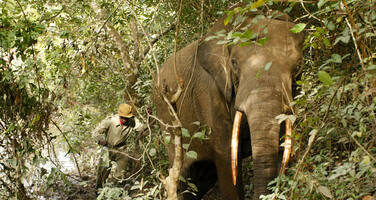Garamba National Park
Factors affecting the property in 1989*
- Illegal activities
- Management systems/ management plan
Factors* affecting the property identified in previous reports
Poaching; Management issues
International Assistance: requests for the property until 1989
Total amount approved : 174,120 USD
| 1988 | Purchase of 2 vehicles to continue the activities of ... (Approved) | 50,000 USD |
| 1986 | Purchase of equipment for the project to protect the ... (Approved) | 20,000 USD |
| 1985 | Equipment for the project to protect the rhinoceros ... (Approved) | 20,000 USD |
| 1985 | Contribution to the project for to rescue the white ... (Approved) | 25,000 USD |
| 1983 | Equipment for rescue programme for white rhino and ... (Approved) | 40,000 USD |
| 1980 | Equipment for Garamba National Park (Approved) | 19,120 USD |
Missions to the property until 1989**
Conservation issues presented to the World Heritage Committee in 1989
The joint project to rehabilitate this Park run by the Frankfurt Zoological Society/WWF/World Heritage Fund with IUCN cooperation has met with considerable success since no more rhinoceros have been poached in the last five years, the rhinoceros population has increased by 50% and a better management regime has been established.
The Park recently celebrated the 50th anniversary since its foundation.
The Bureau noted this situation with satisfaction and recommended that the property be re-examined in 1990: if the situation continued to show improvement, steps should be taken to initiate the removal of the site from the List of World Heritage in Danger.
IUCN, WWF and the Frankfurt Zoological Society are now looking at the next phase of the rehabilitation project maintaining vigilance on the poaching situation, preparing a management plan and looking into work outside the park along the lines of the MAB model. There may well be a request for further support from the World Heritage Fund. The situation will need close attention as the park contains the last viable natural population of square-lipped or northern rhinoceros whose population in 1988 was estimated at 21, up from 15 in 1984.
Summary of the interventions
Decisions adopted by the Committee in 1989
13 BUR IV.A.2
State of conservation
2) Garamba National Park (Zaire)
The joint project to rehabilitate this Park run by the Frankfurt Zoological Society/WWF/World Heritage Fund met with considerable success since no more rhinoceros have been poached in the last 5 years, the rhinoceros population has increased by 50% and a better management regime has been established. The Park recently celebrated the 50th anniversary since its foundation. The Bureau noted this situation with satisfaction and recommended that the property be re-examined in 1990: if the situation continued to show improvement, steps should be taken to initiate the removal of the site from the List of World Heritage in Danger.
13 COM XV.D
List of World Heritage in Danger: Garamba National Park (Zaire)
Garamba National Park (Zaire)
The representative of Zaire thanked the Committee for its continued support for improving the protection and management of this site, which was inscribed on the List of World Heritage in Danger in 1984 due to the alarming reduction in the northern white rhinoceros population. The joint project by the Frankfurt Zoological Society, WWF and the World Heritage Committee had resulted in a promising recovery of these animals. The Committee accordingly recommended that the Zairois authorities should formally request the removal of this site from the List of World Heritage in Danger in 1990.
No draft Decision

Exports
* :
The threats indicated are listed in alphabetical order; their order does not constitute a classification according to the importance of their impact on the property.
Furthermore, they are presented irrespective of the type of threat faced by the property, i.e. with specific and proven imminent danger (“ascertained danger”) or with threats which could have deleterious effects on the property’s Outstanding Universal Value (“potential danger”).
** : All mission reports are not always available electronically.

